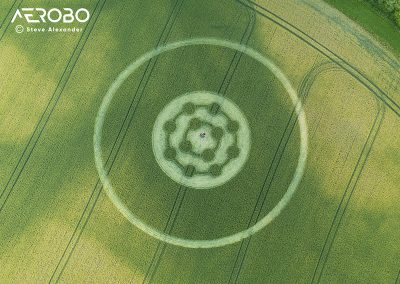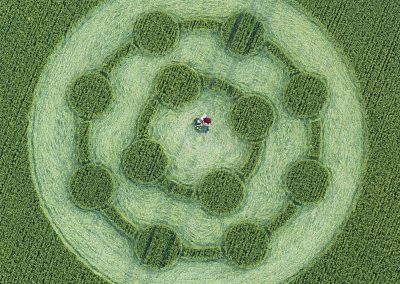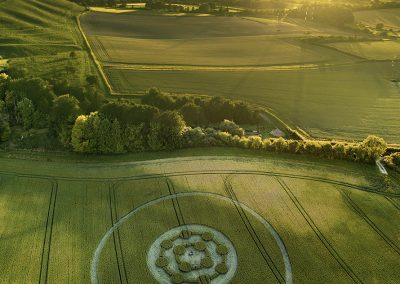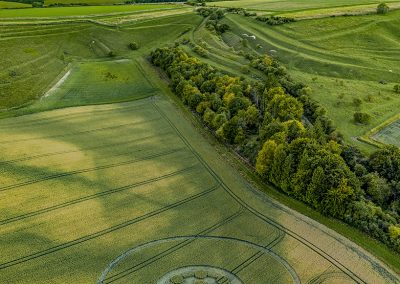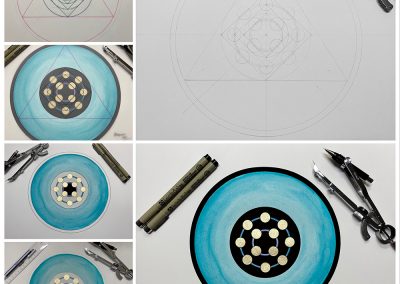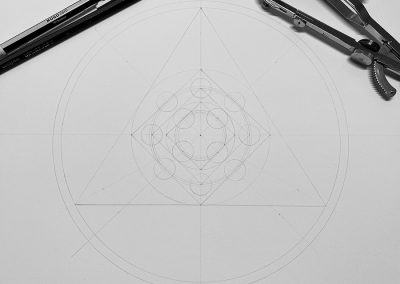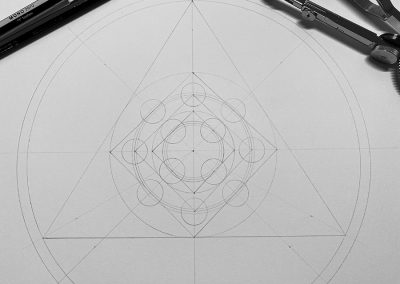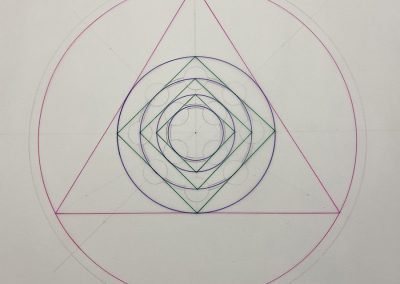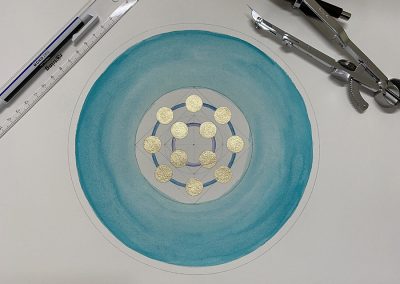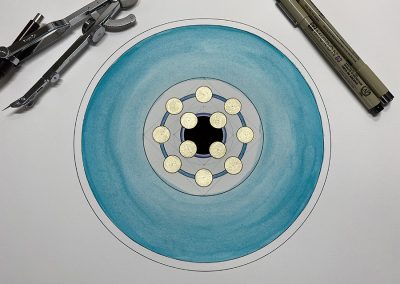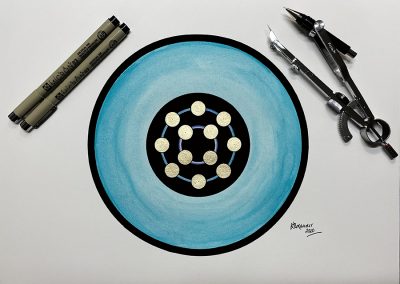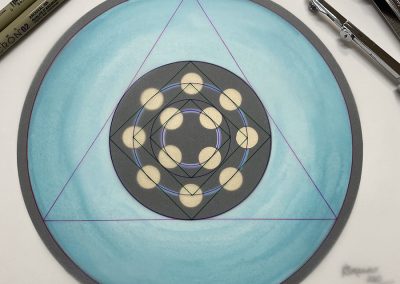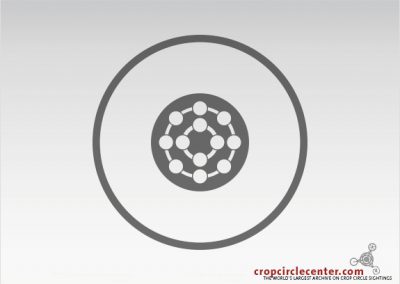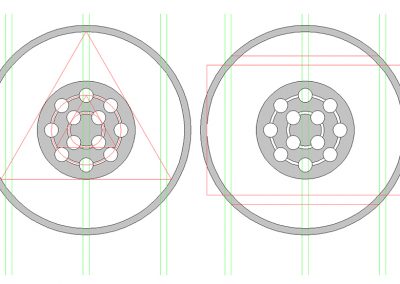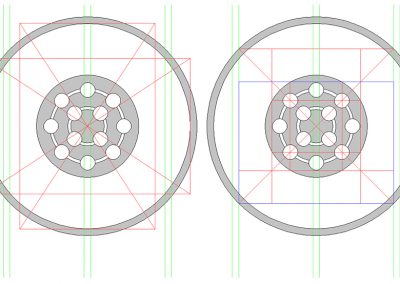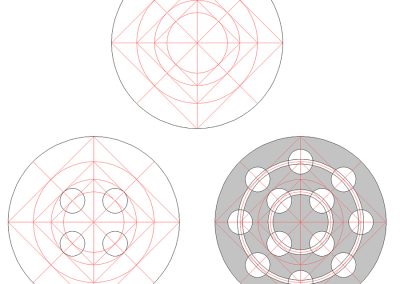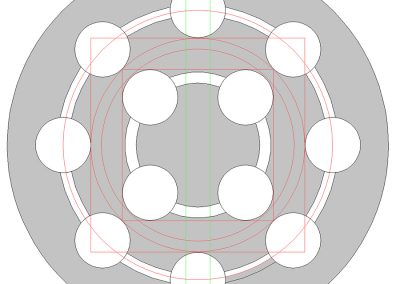Easton Clump, (nr. Eastern Royal), Wilts.
(In the Pewsey Vale)
Detail & Location: This circle was reported on the 10th of July. It is in a field of wheat and measures approximately 200ft in diameter. See the Google Maps link for precise location.
Crop Circle Reporting and Covid-19: After considerable thought and consultation, we have decided we will not be censoring crop circle locations during the Covid-19 pandemic. There are no current restrictions in place in the UK that call for a blanket ban on visiting the countryside. We consider the reporting of crop circles to be in the spirit of journalism, and censorship to be an anathema to that spirit. Therefore, we will be treating the crop circle community as adults and asking everyone to approach the information carefully and responsibly. This will include not visiting the circles if the farmer has not given explicit permission to do so and should permission be given that they practice social distancing by staying 2 metres away from fellow visitors. It would be our very strong advice that visiting the crop circles on the ground should be kept to an absolute minimum for now. However, because we know that the location of any given circle can be important to researchers and those that record the circles from the air, we will continue to share what we know.
Flying during the Covid-19 Pandemic: As yet, because of the current pandemic, we have not been able to take to the air to record the crop circles as we usually would. We are however, very confident that the restrictions keeping us grounded at present will be lifted before too long and we will be able to cover the rest of the season as usual. In the meantime, we are every pleased to have teamed up with the excellent AEROBO (Art in Flight) who will be helping us collect images and drone footage of the latest crop circles to share on the website.
Visiting: The central part of this formation has been cit by the farmer and he wants no visitors to the field. Please respect his wishes.
History & Connections: Nearby Easton Clump is a ‘Disk Barrow’ which dates back to the bronze age (1400-1200 BC). This is yet another crop circle that is placed in connection to an ancient site.
From the Historic England website:
Disc barrows, the most fragile type of round barrow, are funerary monuments of the Early Bronze Age, with most examples dating to the period 1400-1200 BC. They occur either in isolation or in barrow cemeteries (closely-spaced groups of round barrows). Disc barrows were constructed as a circular or oval area of level ground defined by a bank and internal ditch and containing one or more centrally or eccentrically located small, low mounds covering burials, usually in pits. The burials, normally cremations, are frequently accompanied by pottery vessels, tools and personal ornaments. It has been suggested that disc barrows were normally used for the burial of women, although this remains unproven. However, it is likely that the individuals buried were of high status. Disc barrows are rare nationally, with about 250 known examples, most of which are in Wessex. Their richness in terms of grave goods provides important evidence for chronological and cultural links amongst prehistoric communities over a wide area of southern England as well as providing an insight into their beliefs and social organisation. As a particularly rare and fragile form of round barrow, all identified disc barrows would normally be considered to be of importance. Despite damage caused by the significant wind throw of trees in 1990 the disc barrow 665m north west of Hill Barn survives well and will contain archaeological and environmental evidence relating to its construction, longevity, territorial significance, social organisation, funerary and ritual practices and overall landscape context.
Design & Symbolism: This centre of this circle is a variation on the classic quintuplet design, so often seen in crop circles – like the five-dot face on a die – four circles around a central fifth. This formation is eight-fold in design. There are some very nice proportioning ratios going in in this circle. See the Geometry Gallery below for further details as we have them.
Visiting the Circles? If you are thinking of visiting any crop circles this summer, please read our Visiting the Crop Circles section. It’s full of useful information and etiquette for visiting the countryside and the crop circles. Please remember that you should not enter any fields without the express permission of the farmer and you will need to be aware of and abide by any restrictions in place in the UK in response to the Covid-19 pandemic.
Click here for Copyright Information about the reproduction of images on this website.
Please Help to keep us Flying in 2019: If you have enjoyed looking at our pictures and information please consider making a small donation to keep us flying. There are so few of us left regularly recording the circles it’s really important that we continue. And while some now use drones to record the circles, it is important that there are still images taken from aircraft where the best quality camera equipment can be used and images that include the broad vista of the landscape can be taken. This kind of photography is expensive and it gets harder with each passing year to raise the funds we need to continue our work, but if everyone who regularly looked at this website made a small donation we would meet the funds we need. You can make a donation here.
NOTE: Some of the images below are beautiful landscape scenes. Click on each image to enlarge them and see the whole picture.
Important Thanks:
We’d like to say a special thanks to AEROBO for getting to his location so quickly and crucially, just in time before the farmer cut this formation. The effort included having to drive home and back for more batteries for the drone before the light went. Many thanks, we deeply appreciate it!
Image Licencing
We can supply high resolution images of many of our photographs and the sky is the limit as to what they can be used for! Choose from our extensive library or contact us to commission aerial photography for your project.
Geometry Gallery
Four-ness and the implicate whole
By Karen Alexander
The Eastern Royal crop circle of 2020 is deceptively simple. But as sometimes is the case with the crop circles, there can be hidden dimensions to their geometry.
A dissonant juxtaposition
The first thing to notice in this crop circle is its compact central pattern. This is a little unusual and creates a slightly dissonant juxtaposition between the expansive area of standing crop between the perimeter of the circle and the centre circle, and then the relatively tightly packed pattern in the centre. It creates an unease the viewer, and also a curiosity to understand what might be happening.
Hawkins’ diatonic ratios
On the drawing board the first relationship of note is one between the inner perimeter circle and the central circle. This relationship is defined by an equilateral triangle.
This ratio was remarked upon by Gerald Hawkins when he explored the geometry of the crop circles, the relationship is equal to a 4:1 diatonic (musical) ratio.
The ratio of the perimeters of the two and circles is 4:1 and the area of the larger circle is exactly three times that of the smaller circle. This is true whatever scale you work at.
After working with some crop circle designs, in 1992 astronomer Gerald Hawkins published what he believed to be a new series of theorems relating to relationships of polygonal shapes inscribed in circles. And while the yah-boo debunkers have been all over this like a nettle rash, the fact remains that these theorems had not been fully recognised and articulated until they were published by Hawkins as a direct result of his work with the crop circles. They were certainly not found amongst Euclid's works - some have claimed Kelper knew of some of them - but this is rather unclear. And the idea that they were so simple as to warrant little comment is simply ignorant. Many ratios are simple, but they are still ‘ever true’ and that is what makes them very important mathematical proofs.
(You can find these theorems in the appendices of the book ‘Crop Circles’ by Michael Glickman, published by Wooden Books).
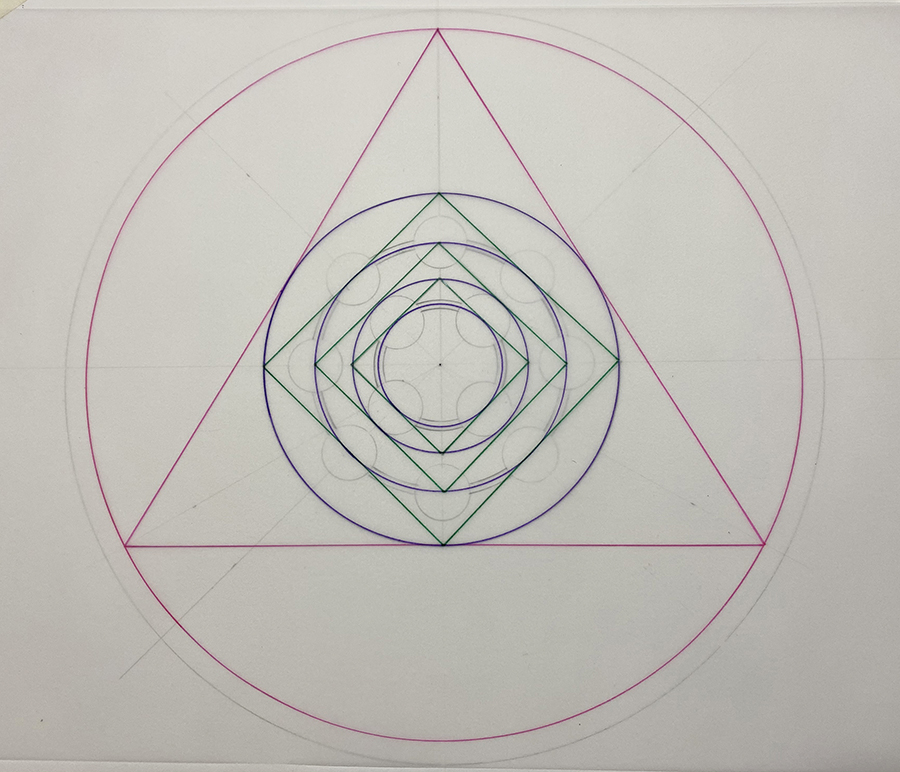
The ordering geometry of the Eastern Royal 2020 crop circle - by Karen Alexander
The inner pattern
The pattern in the inner circle reminded me of an 'electron shell diagram’, where the number of electrons in an element are shown as dots on rings, but this may well be a visual similarity only. I do not think there is a diagram that corresponds with this circle. But, those inner rings and circles in the formation are organised by an unseen set of squares - see the illustrations below in the geometry gallery for an illustration of how this works.
Four-ness and the implicate whole
For all its seeming simplicity this crop circle was underpinned by some very elegant proportions, ratios and geometry.
I like the link between the underpinning squares (4) in the central circle and the 4:1 ratio in the outer to inner circle relationship and the 4 and then 8 dots in the centre of the formation - there seemed to be a multidimensional echoing of four-ness going on.
After taking a crop circle apart to look at its constituent parts, we must always remember to reassemble the parts and view the formation as a whole. It seems to me each new circle is also part of the whole of the phenomenon, each a single point in a continuing process.
Four is the number of material reality, matter, mater, mother substance. It is the matter that clothes the energy and forces of the cosmos. In the same way, in this crop circle, four-ness is the implicate cornerstone of its geometry and also its manifestation/creation in matter. The fact that all this is enclosed in a circle, gives a sense of the wholeness of this process. In some ways it it like the electron shell diagrams, as it echos the idea of the ordering of the forces of nature in matter, by geometry.
Please do also look at the work done by researcher Peter van den Burg on this formation (below), he found further intriguing relationships worth taking the time to look at.
I thoroughly enjoyed exploring and drawing this crop circle - please enjoy the pictures below.
Thanks & Credits
I would like to thank some of my crop circle cognoscenti for their help in forming these ideas: Steve Alexander, Peter van den Burg and Jonathan-Paul DeVierville
Text | Hand-drawn Images by Karen Alexander.
With special thanks to Peter van de Burg for his thoughts, perspectives and analysis. You can see more of his great work on his Facebook page Geometry of the crop circles.
Please enjoy the diagram below by Bertold Zugelder.
Further Thoughts by Peter van den Burg
Start with three nested squares and places the four satellites on the smallest radius, tangent to that of the second square. The outer radius of the smallest standing ring is determined by the crossing of the satellites with the square. Use this distance to determine the inner radius as well, and make the larger standing ring equal in width to the first.
The outer ring stands in a 2:1 proportion with the central part. Unusually, this seems to be measured from the inner radius of the ring. I don't suppose it is unprecedented, but i can't think of another example with this quality straight away. (Although this curious play with inner- and outer radii was a theme at the Hunt's down formation from june 17 as well. Which, apropos, had an outer radius equal to the inner radius of Easton clump).
Now that the tramlines are straight again we can recognise a square aligned with the medial track. A Golden rectangle, together with the square determines the dimensions of the ring.
This is pretty, but, too, unconventional. These combinations with squares and Golden rectangles usually lead to a Squared circle, but not in this case.
The relation ring- central part can be found playing some more with Golden proportions. Two √ɸ rectangles inside the square (one in blue, one in red) will bind ring and centre together and determines the octagonal ring inside.
The central part iself makes for two elegant Squared circles.
Date
10.07.2020
Crop
Wheat
Visiting
The farmer has cut the centre of the circle out. He asks no-one visit the field. Thank you.
Google Maps Link


